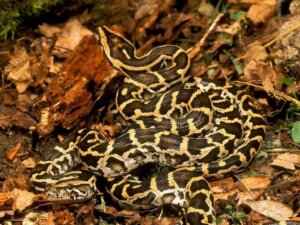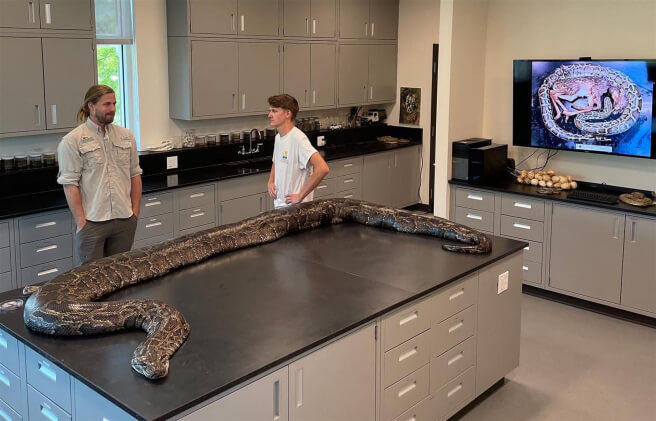Why Can the Burmese Python Swallow Almost Anything?


Written and verified by the biologist Georgelin Espinoza Medina
Snakes are amazing animals. They can move with such agility on the ground, in the trees and even in the water, despite its lack of limbs. A bold hunter with a versatile jaw to gobble prey with ease. And there’s one particular snake that stands out for the flexibility of its mouth opening, which can help it swallow almost anything. We’re talking here about the Burmese python.
It belongs to the Pythonidae family, which has about 38 species. Its scientific name is Python bivittatus. Some time ago it was known as Python molurus bivittatus, because it was thought to be a subspecies of the Indian python. In this article, we’ll bring you all the details of the general characteristics of this snake and why it can open its mouth so wide to swallow large prey. Don’t miss it!
Characteristics of the Burmese python
These pythons stand out for their size and robustness, as they can reach up to 5 meters (16.4 feet) in length and 100 kilograms (220 pounds) in weight. They have light coloration, with brown spots and black borders on the dorsal part of their body. The ventral region is light. However, in captivity, it’s more common to have paler specimens with yellow and orange patterns.
The Burmese python is native to the Asian continent, but thanks to its pet trade it was introduced in North America. Today, it remains well established as an invasive species that impacts the ecosystem and natural fauna of the region.
However, although it’s successful as an invasive species in Florida, in its place of origin it’s threatened with extinction. It’s on the red list of the International Union for Conservation of Nature (IUCN). International Union for Conservation of Nature in the vulnerable category. Threats include illegal trade, habitat degradation, and hunting and capture of individuals for use in food production or for their skins.
What does the Burmese python eat?
Like all other snakes, this python is carnivorous. It has a generalist diet, which includes a variety of mammals, birds, amphibians, and reptiles.
The python snake isn’t venomous, but is very strong. It doesn’t go after prey, but rather waits stealthily for them to approach, then attacks them and wraps its body around them, killing them by constriction. After that, it swallows them whole without chewing them.
This snake can include in its diet large mammals such as deer weighing more than 50 kilograms (110 pounds) and other animals, including alligators.
Why can the Burmese python open its mouth so wide and swallow almost anything?
In general, snakes have good flexibility to swallow prey whole, some of them even larger than themselves. This happens because they have a skull formed by parts with mobile articulations, which is known as kinetic. Among these pieces we have the bones of the lower jaw to provide flexibility.
In addition to this, the snake’s length and large head are other factors that enable them to open their mouths wider than most snakes.
However, the most important element that allows greater elasticity is the soft tissue present between the jaws. This skin is more flexible, so its distension creates a larger mouth opening than in other species studied so far. This is detailed in a study published in the journal Integrative Organismal Biology last year (2021).
The study compared the Burmese python with another snake, the brown tree snake (Boiga irregularis), which, although it had longer jaw bones, had a much smaller opening. In fact, it was up to 4 to 6 times smaller, because the distension of its soft tissues was smaller.
This snake can eat larger prey

As can be expected, a larger mouth opening provides a clear advantage, being able to ingest prey superior in size. Among the victims of these ferocious predators are leopards, antelopes, deer, goats, wild boars, alligators, bobcats, blue herons, and others. In Florida, Burmese pythons are wiping out native wildlife and damaging the ecosystem.
In summary, the Burmese python has a greater ability to open its mouth compared to other species (such as the brown tree snake). This attribute comes from a combination of characteristics, such as the size of its head and body. And, in particular, the presence of inter-jaw soft tissues that allow for greater extension and flexibility. This ability makes it an even more fearsome predator, as it’s able to consume larger prey.
Snakes are amazing animals. They can move with such agility on the ground, in the trees and even in the water, despite its lack of limbs. A bold hunter with a versatile jaw to gobble prey with ease. And there’s one particular snake that stands out for the flexibility of its mouth opening, which can help it swallow almost anything. We’re talking here about the Burmese python.
It belongs to the Pythonidae family, which has about 38 species. Its scientific name is Python bivittatus. Some time ago it was known as Python molurus bivittatus, because it was thought to be a subspecies of the Indian python. In this article, we’ll bring you all the details of the general characteristics of this snake and why it can open its mouth so wide to swallow large prey. Don’t miss it!
Characteristics of the Burmese python
These pythons stand out for their size and robustness, as they can reach up to 5 meters (16.4 feet) in length and 100 kilograms (220 pounds) in weight. They have light coloration, with brown spots and black borders on the dorsal part of their body. The ventral region is light. However, in captivity, it’s more common to have paler specimens with yellow and orange patterns.
The Burmese python is native to the Asian continent, but thanks to its pet trade it was introduced in North America. Today, it remains well established as an invasive species that impacts the ecosystem and natural fauna of the region.
However, although it’s successful as an invasive species in Florida, in its place of origin it’s threatened with extinction. It’s on the red list of the International Union for Conservation of Nature (IUCN). International Union for Conservation of Nature in the vulnerable category. Threats include illegal trade, habitat degradation, and hunting and capture of individuals for use in food production or for their skins.
What does the Burmese python eat?
Like all other snakes, this python is carnivorous. It has a generalist diet, which includes a variety of mammals, birds, amphibians, and reptiles.
The python snake isn’t venomous, but is very strong. It doesn’t go after prey, but rather waits stealthily for them to approach, then attacks them and wraps its body around them, killing them by constriction. After that, it swallows them whole without chewing them.
This snake can include in its diet large mammals such as deer weighing more than 50 kilograms (110 pounds) and other animals, including alligators.
Why can the Burmese python open its mouth so wide and swallow almost anything?
In general, snakes have good flexibility to swallow prey whole, some of them even larger than themselves. This happens because they have a skull formed by parts with mobile articulations, which is known as kinetic. Among these pieces we have the bones of the lower jaw to provide flexibility.
In addition to this, the snake’s length and large head are other factors that enable them to open their mouths wider than most snakes.
However, the most important element that allows greater elasticity is the soft tissue present between the jaws. This skin is more flexible, so its distension creates a larger mouth opening than in other species studied so far. This is detailed in a study published in the journal Integrative Organismal Biology last year (2021).
The study compared the Burmese python with another snake, the brown tree snake (Boiga irregularis), which, although it had longer jaw bones, had a much smaller opening. In fact, it was up to 4 to 6 times smaller, because the distension of its soft tissues was smaller.
This snake can eat larger prey

As can be expected, a larger mouth opening provides a clear advantage, being able to ingest prey superior in size. Among the victims of these ferocious predators are leopards, antelopes, deer, goats, wild boars, alligators, bobcats, blue herons, and others. In Florida, Burmese pythons are wiping out native wildlife and damaging the ecosystem.
In summary, the Burmese python has a greater ability to open its mouth compared to other species (such as the brown tree snake). This attribute comes from a combination of characteristics, such as the size of its head and body. And, in particular, the presence of inter-jaw soft tissues that allow for greater extension and flexibility. This ability makes it an even more fearsome predator, as it’s able to consume larger prey.
All cited sources were thoroughly reviewed by our team to ensure their quality, reliability, currency, and validity. The bibliography of this article was considered reliable and of academic or scientific accuracy.
- Guzy, J., Falk, B., Smith, B., Willson, J., …& Hart, K. (2023). Burmese pythons in Florida: a synthesis of biology, impacts, and management tools. Neobiota, 80, 1-119.
- Jayne, B., Bamberger, A., Mader, D., & Bartosgek, I. (2022). Scaling relationships of maximal gape in two species of large invasive snakes, brown treesnakes and Burmese pythons, and implications for maximal prey size. Integrative Organismal Biology, 4(1), 1-18.
- Krysko, K., Reed, B., & Rodda, G. (2018). Python bivittatus (Burmese python). Recuperado el 23 de enero de 2023, disponible en: https://www.cabidigitallibrary.org/doi/10.1079/cabicompendium.66412
- Harvery, R., Brien, M., Cherkiss, M., Dorcas, M., Rochford, M.,Snow, R., Mazzotti, F., & Domínguez, M. (2008). Pitones Birmanas en Florida del Sur. Soporte científico para el manejo de especies invasoras. Universidad de Florida. Recuperado el 23 de enero de 2023, disponible en: https://crocdoc.ifas.ufl.edu/publications/factsheets/Burmese%20pythons%20in%20S%20FL_IFAS%20factsheet_spanish_final_NPS.pdf
- Stuart, B., Nguyen, T.Q., Thy, N., Grismer, L., Chan-Ard, T., Iskandar, D., Golynsky, E. & Lau, M.W.N. 2012. Python bivittatus (errata version published in 2019). The IUCN Red List of Threatened Species 2012: e.T193451A151341916.
This text is provided for informational purposes only and does not replace consultation with a professional. If in doubt, consult your specialist.








